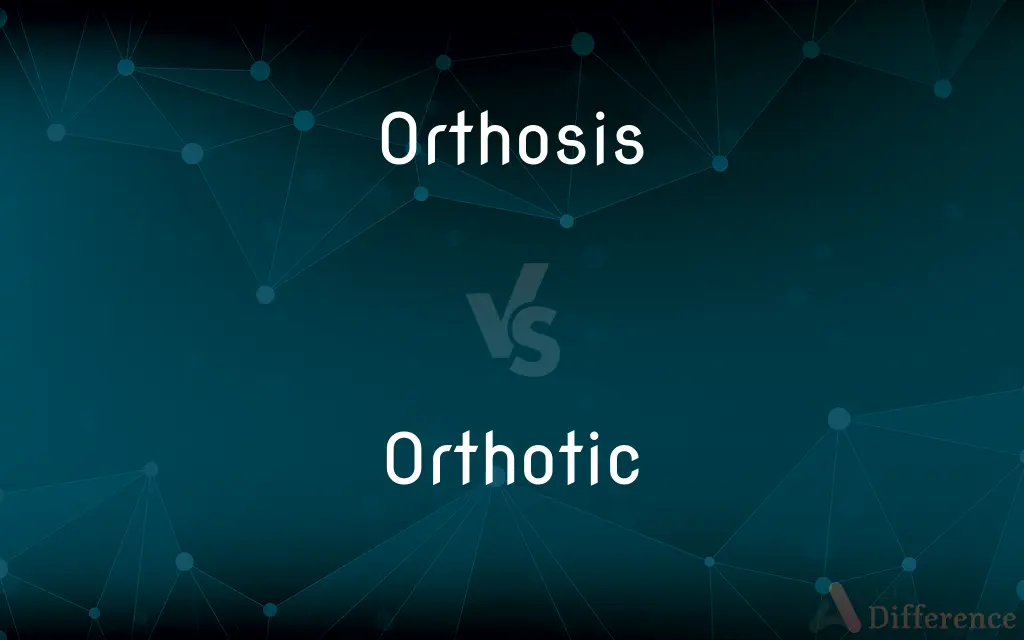Orthosis vs. Orthotic — What's the Difference?
By Maham Liaqat & Urooj Arif — Updated on March 18, 2024
Orthosis refers to a device aiding body alignment or function, while orthotic often denotes insoles or shoe inserts for foot support.

Difference Between Orthosis and Orthotic
Table of Contents
ADVERTISEMENT
Key Differences
An orthosis is a medical term for a brace or support designed to correct or assist the alignment, supporting, or movement of the limb, spine, or other body parts. On the other hand, the term orthotic is commonly used to refer specifically to shoe inserts designed to support, align, or improve the function of the foot.
The customization and fitting process differentiates these terms further. Orthoses are typically prescribed by healthcare professionals like orthotists, physiotherapists, or doctors, and are custom-fitted to the individual’s specific anatomical and functional needs. This process ensures that the device properly addresses the medical condition it’s meant to help. Orthotics, especially those related to foot care, can also be custom-made but are more commonly available in pre-made forms. Custom orthotics require a fitting process by a professional, often involving analysis of the person’s gait and the way they distribute their weight on their feet.
The scope of application is another distinguishing factor. Orthoses cover a broader range of devices intended for various parts of the body, addressing a wide variety of medical issues from minor ailments to complex disabilities. Orthotics, while they can technically be considered a subset of orthoses, are primarily focused on correcting foot-related issues and improving foot function.
In terms of impact, both orthoses and orthotics play crucial roles in rehabilitative medicine, helping individuals achieve better mobility, reduce pain, and improve their quality of life. They work by providing support, relieving pressure on certain areas, and assisting or correcting movement, thereby enabling more independence and activity in daily life.
Comparison Chart
Definition
A device to correct or support body parts
Shoe inserts for foot support
ADVERTISEMENT
Common Uses
Limb, spine, joint support
Foot alignment, pain relief
Customization
Often custom-fitted
Can be custom or pre-made
Scope
Broad, for various body parts
Primarily focused on feet
Prescription
By healthcare professionals
By professionals or over-the-counter
Compare with Definitions
Orthosis
Custom-fitted brace for physical rehabilitation.
After the surgery, he needed an orthosis for his knee.
Orthotic
Can be bought over-the-counter or custom-made.
He uses over-the-counter orthotics for extra arch support.
Orthosis
Aids in movement or reduces discomfort.
Her wrist orthosis reduces pain during typing.
Orthotic
Used for correcting flat feet or arch issues.
Orthotics are recommended for her flat feet.
Orthosis
A supportive device for limbs or spine.
The spinal orthosis helped correct her posture.
Orthotic
Often part of a broader treatment plan for foot health.
Alongside physiotherapy, orthotics provide relief from plantar fasciitis.
Orthosis
Used for a wide range of medical conditions.
Orthoses are vital for many with congenital limb differences.
Orthotic
Focuses on improving foot function.
Custom orthotics help align her stride.
Orthosis
Designed by specialists like orthotists.
The orthotist designed a unique orthosis for her condition.
Orthotic
Insoles designed for foot support.
Running shoes with orthotics can help prevent injuries.
Orthosis
(medicine) A type of brace which either prevents or assists movement of a limb or the spine.
Orthotic
An orthopedic appliance designed to straighten or support a body part.
Orthotic
Of or relating to orthotics.
Orthotic
Of or pertaining to orthotics.
Orthotic
(typography) Of Greek typography: having an upright form, distinct from the cursive and chancery types.
Orthotic
An orthopedic appliance designed to support, straighten or improve the functioning of a body part; an orthosis.
Common Curiosities
What conditions do orthoses address?
Orthoses can address conditions affecting the limbs, spine, and joints, from congenital abnormalities to recovery support after injuries or surgeries.
Can anyone use orthotics?
While anyone seeking to improve foot comfort or function might use over-the-counter orthotics, specific conditions should be addressed with custom orthotics prescribed by a professional.
Do insurance plans cover orthoses and orthotics?
Many insurance plans cover these devices, especially when prescribed for specific medical reasons, but coverage details vary.
How long do I need to wear an orthosis or orthotic?
The duration depends on the individual’s condition and response to the device. Some might be temporary, while others might be needed long-term.
Is there a difference in cost between orthoses and orthotics?
Costs can vary widely based on customization, materials, and the specific device, with custom devices typically costing more than over-the-counter options.
How do I know if I need an orthosis or orthotic?
Consultation with healthcare providers like orthotists, podiatrists, or physiotherapists can determine if you need an orthosis or orthotic, based on your condition and symptoms.
Can orthotics help with knee or back pain?
Yes, properly aligned orthotics can help redistribute weight and improve posture, potentially relieving knee or back pain.
Do I need a prescription for orthotics?
For custom orthotics, yes, a prescription from a healthcare provider is typically required. Over-the-counter options are available without a prescription.
Are all foot supports considered orthotics?
Yes, all devices designed to support, align, or improve the function of the foot can be considered orthotics, including insoles and shoe inserts.
Are orthoses and orthotics only for athletes?
No, they are used by individuals of all ages and activity levels to address medical conditions, improve mobility, and enhance quality of life.
Can orthoses or orthotics be adjusted after fitting?
Yes, adjustments might be necessary to ensure optimal comfort and function as the individual's condition improves or changes.
Can children use orthoses or orthotics?
Yes, children may use them to address congenital conditions, support development, or assist in rehabilitation from injuries.
How do I care for my orthosis or orthotic?
Follow the manufacturer’s or provider’s instructions for care, which may include regular cleaning and avoiding exposure to extreme temperatures or moisture.
How are orthoses and orthotics maintained?
Maintenance involves regular cleaning, inspection for wear, and adjustments as needed, with specifics depending on the material and design.
How do orthoses and orthotics improve quality of life?
By supporting and correcting body alignment, they can reduce pain, enhance mobility, and enable more active and independent living.
Share Your Discovery

Previous Comparison
Simplicity vs. Simplistic
Next Comparison
Nonregistered vs. UnregisteredAuthor Spotlight
Written by
Maham LiaqatCo-written by
Urooj ArifUrooj is a skilled content writer at Ask Difference, known for her exceptional ability to simplify complex topics into engaging and informative content. With a passion for research and a flair for clear, concise writing, she consistently delivers articles that resonate with our diverse audience.
















































